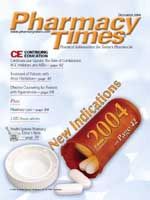Publication
Article
Pharmacy Times
CASESTUDIES
Author(s):
Case One: VN is a 55-year-old man with a 5-year history of type 2 diabetesmellitus. His medical history also is significant for hypertensionand dyslipidemia. His wife has brought him to the physician'soffice. She thinks that VN has been acting strangelyrecently. VN agrees that he has not been feeling like himself.
Upon questioning, the doctor learns that VN does not monitorhis blood glucose levels. VN has noticed an increased frequencyof urination, fatigue, and decreased appetite. The doctornotices that VN appears disoriented and confused. VN's vitalsigns are recorded as follows: blood pressure 130/65 mm Hgsupine and 90/50 mm Hg sitting; heart rate 100 beats/min; respiratoryrate 22 breaths/min; and temperature 39ºC. His skinturgor is poor, and his mucous membranes are dry. Significantlaboratory findings include blood urea nitrogen 55 mg/dL, serumcreatinine 3.3 mg/dL, and glucose 730 mg/dL. Other laboratoryfindings are within normal limits.
According to his medical record, VN's current medicationsinclude glipizide 10 mg twice daily, atorvastatin 10 mg daily,hydrochlorothiazide 50 mg daily, and enteric-coated aspirin daily.
The physician suspects that VN has developed hyperosmolarhyperglycemic state. What measures should be taken totreat VN?
Case Two: PT, a 50-year-old man, presents to his doctor's office complainingof severe toe pain. He has difficulty sleeping, walking,or wearing a shoe. Acetaminophen has not relieved the pain.
On examination, the physician finds that the first joint of PT'sbig toe is swollen, warm, erythematous, and extremely tender.The rest of the physical examination findings and laboratory valuesare within normal limits except for uric acid, which is reportedas 12 mg/dL.
The physician obtains an x-ray and synovial fluid aspirate ofthe toe. The x-ray shows soft tissue swelling without evidenceof trauma or fracture. The synovial fluid shows numerous neutrophilsand intracellular monosodium urate crystals.
The physician suspects that PT has gout with hyperuricemia.He decides to start PT on ibuprofen and colchicines. He also willobtain a 24-hour urine collection to determine whether PT is anoverproducer or an underexcreter of uric acid. This finding willdetermine whether the patient should receive treatment withallopurinol or probenecid. The physician also wants to considerother possible causes for PT's elevated uric acid levels.
PT's current medications are simvastatin, loratadine, andhydrochlorothiazide. Has PT been taking any medications thatmight alter his uric acid level?
Dr. Schlesselman is a clinical pharmacist based in Niantic, Conn.
Click Here For The Answer ----------->
[-]
CASE ONE: VN should be treatedwith insulin and oral fluids. The insulin isnecessary to reduce his glucose levels,whereas the fluids are necessary to correcthis dehydration. During rehydration,VN also may need potassium, sodium,and phosphorus replacements. Althoughthe patient's potassium, sodium,and phosphorus levels appear normalbefore rehydration, this finding is due tohemoconcentration and shifting of ionsdue to VN's hyperosmolar and hyperglycemicstate.
CASE TWO: Hydrochlorothiazideuse is associated with elevated uric acidlevels and precipitation of acute goutyepisodes. Thiazide diuretics are weakacids that are secreted by the proximalrenal tubules. It is suspected that thiazidediuretics and uric acid compete forrenal excretion. Because of this competition,higher doses and chronic use ofhydrochlorothiazide are more likely toinhibit excretion of uric acid.
toggle(getObject('exp1048685570_link'), 'exp1048685570');







